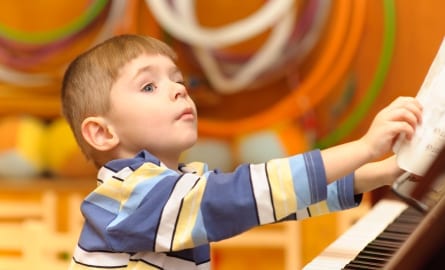‘Creative Practicing’ improves technique but also builds your child’s motivation and self-esteem!
“I don’t want to practice!” This daily statement can be like acrylic fingernails on a long chalkboard. The add-on sentence “Practicing is boring” is just as ugly to the point that you almost prefer to hear the nails instead of the whine. And when kids perpetually conclude their little paragraph with an “I want to quit!”…you almost want them to do just that–for you’re tired of the nagging. The reprimanding. The aggressive sigh your kid makes moments before picking up the musical instrument or whatever needs to be practiced. The teacher’s expression when you tell her your kid hasn’t practiced. And then what do you do? Even the most strong-willed parents can’t endure years of ‘motivating’ their child to practice, and so they pull him or her out. “My child won’t practice,” they confess. “I guess that music (or sport or hobby) isn’t her thing.” But that’s just it: It CAN be her thing…she just doesn’t know it yet. Why? Because she has to explore and discover it. She has to learn HOW to practice independently and how to measure results. But most importantly, she has to be inspired. Because if she becomes passionate about what she is learning, she will never have to be forced to practice. First, though, to truly reap the benefits of being skillful at something, she has to become good at it, and you will have to guide her in this. Unfortunately, it takes time. It also involves practicing—actually, ‘creative practicing’. There’s a difference.
Traditional Practicing v. Creative Practicing
In my experience as a musician and a teacher, the traditional perspective and approach to practicing are grounded in rules, routine and rigidity. Theory, hand placement, and performance are paramount. That’s important, of course! (I’m speaking mostly about playing musical instruments, for I have been a music teacher for almost 20 years.) However, too much focus on technique, form and posture–in the very beginning–can stifle a child, especially a young one, or even a teenager. When my son was four years old (before I started teaching him), his piano teacher made him practice music theory flash cards and memorize terms and note placement. No four-year-old should have to memorize flash cards. They don’t even know why they’re learning it. Ask them what type of music they like, and their first response might be “ummm.” It’s why I especially love when I teach children under the age of six. On the first day, I teach the little boys how to play the first few notes of the “Star Wars” theme song, and they’re hooked. The little girls learn the first few notes of “Part of Your World,” and music is suddenly their passion. Passion begets curiosity begets longevity. I’ve heard the parents of my students tell me they wish they would have stuck with piano or guitar or violin but that they hated practicing. It wasn’t the practicing they hated, however; it was what they had to practice and the negative reinforcement that made them quit.
‘Creative Practicing’ is built on the assumptions that most kids 1) don’t know ‘HOW’ to practice successfully, 2) don’t really value the benefits of practicing until they have actually experienced and recognized them, 3) need to use their imagination and creativity in whatever musical activity they pursue, and 4) need to be inspired.
How-To Tips
The following are just simple how-to steps to help you change your child’s perspective about practicing. Change the perspective, and you change the approach. Here’s some creative ways to do that.
1. Change how your child views practicing. One very simple way is to not refer to it as ‘practice.’ With young kids, for example, you could call it ‘music play.’ Of course this ‘play’ is more of the structured type of play, but the word “play” is so much more positive and fun to a little child than “practice.” Promote this ‘music play’ as an opportunity or a privilege, instead of a chore. Part of changing your child’s view is essentially changing your own.
2. Teach your child HOW to practice. Depending on the teacher, this may be told instead of taught. Many teachers have a regimented way they want the child to practice. Some kids thrive on that; others won’t. If they don’t, then get creative. One way to do that is to create a ‘Piano Plan’ or ‘Guitar Plan’, etc. For example, write five steps and then at the bottom draw some empty boxes. “Step One: Play ‘Yankee Doodle’ 3 times. Step Two: Play the right hand of ‘Jingle Bells’ 2 times and then left hand 2 times.” When the child gets to the fifth step, he may draw a picture (or put a sticker) in one of the boxes. The next time he completes all five steps, he gets to fill in another box. This way, he can literally measure his success…via boxes. When all boxes are completed at the end of the week he receives a treat or a positive reinforcement.
3. Empower your child with a sense of independence. I have some students create their own practicing plan, but then they have to stick to it. For the young ones, I let them ‘help’ me create a piano plan. For example, they get to tell me how many times they’ll play a song. This holds them accountable as well as empowers them. In fact, some of my students commit to more than what I would have assigned. One ambitious seven-year-old boy told me he was going to practice his song 60 times. And, he did!!! There were stickers covering the entire page.
4. Provide incentives and rewards. Note that rewards are different than bribes. A bribe tells them that if they do this, then you’ll give them that. A reward is acknowledging what they’ve already done. For example, maybe each time they practice, they get to put a dime in the music jar. When the jar is filled, they may use that money to buy a new music book.
5. Give them goals. Kids are not interested in long-term goals. Our beloved promise that “one day you’ll appreciate this” does nothing for them. Create goals: ones that appeal to your child. Inspire them. Not every kid craves recitals. But, he might be excited at the idea of you inviting the grandparents over for a performance in a month from now. Or, maybe there is a school talent show in a few months. I’ve found that the older kids like to (or are required to) do community service hours. Playing piano in a senior center is always a nice opportunity to use one’s skills for the good of society. Schedule the date and tell your teenager she is accountable to that. She won’t want to disappoint an entire room of senior citizens.
6. Appeal to your child’s creativity. Never believe anybody who tells you that your child is too young to compose music. Of course, they might be too young to write down the notes, but that doesn’t matter. What matters is that they discover the beauty in creating music–even if it’s just playing a new little tune they made up. There’s many creative things you can do with that. You can record it on CD or DVD and give it to friends as a gift. Last Christmas, I recorded songs for each of my students, and created personalized ‘albums.’ All of them were so inspired to finish their songs so they could add them to the CD. Practicing the songs became a natural habit. My sons gave their teachers their piano albums, and we even made album covers. Or, if your child is older, he or she can write down the original song. Have him or her title it, sign it, frame it, and then give it as a gift. Your children may not be rehearsing a Beethoven piece for an upcoming competition, but they are doing something just as profound: They are discovering (and creating!) music.
7. Let your child teach you or somebody else. I was classically trained in music for nine years, but it wasn’t until I started teaching it as a teenager that I saw music from a completely different perspective! Many children love teaching other children as well as their parents. It empowers them. My older son occasionally teaches my younger son something, and if all goes well, I’ll ‘pay’ him. Heck, I’ll even pay the younger one a tiny something for good listening and follow-through. There are lessons (and benefits!) in teaching others that can’t be taught by somebody else. One of my eight-year-old students was so proud to share that she taught her four-year-old brother how to play a song. This is not traditional practicing, but it is creative practicing. And through it all, the child is building self-esteem.
8. Be creatively consistent. Just because the practicing approach is creative, that doesn’t mean that the child can choose when he or she wants to practice. I’m betting any child who gets to choose between practicing something or playing a video game will choose the latter. Enforce a consistent schedule, but let him or her be a part of creating that schedule. For example, if your child needs to practice five times a week, have him plan out the five days ahead of time and then hold him accountable to it. Make it part of their normal routine. I found that my kids like to practice right before bed, so I made it part of their bedtime routine. They eat dinner, bathe, put their PJs on, and then practice piano. After that is reading and lights out. Some kids are more productive right after school. Whatever is your child’s optimal practicing time, make it part of their routine. Soon, it will be a natural habit…just like brushing teeth.
9. Show them their progress. Don’t wait until a recital for them to feel validated at all their hard work. They need to SEE the results of their practicing firsthand. One creative way to do this is to videotape them playing a song. Then have them practice it for two weeks. Videotape them again, and then show both video files. There’s a reason why many of us love watching weight-loss shows. The ‘before’ and ‘after’ pictures are powerful, aren’t they?
10. Enjoy them. As parents, we’re really good at ‘helping’ our kids perform better. We point out what they need to work on and tell them when they have made an ‘oopsy’ when they’ve messed up. But, despite our best intentions this ‘feedback’ is often interpreted by the child as criticism. Take the time to relax on the couch and just quietly listen to your child. Appreciate him and encourage him. Let the teacher provide the ‘helpful’ feedback.
Bottom line: You know your children best and what makes them tick. You know what they value and what motivates them. Use that to your advantage. Thread that deeply into the art of practicing. Don’t be afraid to go against the traditional or the standard. Customize a practicing plan to your child that builds him up and inspires him. Remember: At some point, the ‘honeymoon’ period will most likely end with any instrument, any sport, any hobby. But that’s normal. Learning music won’t always be fun. It’s during those moments when they’re feeling ‘low’ that you can switch it up a bit and be creative. Have a little fun. There are ups and downs to everything we do. We don’t like our job every day, but we learn how to deal with it. It’s the same when it comes practicing. Just like music has different notes and rhythm, so will practicing. The point is to help your child discover his own melody.





